#palp footed spider
Explore tagged Tumblr posts
Photo



Common palp-footed spider, Palpimanus sp., Palpimanidae
Photographed in South Africa by hrodulf
#animals#curators on tumblr#bugs#arachnids#spider#palp footed spider#common palp footed spider#one nice bug#look at her face!!!#and her rotund butt#10/10#NAY#12/10
676 notes
·
View notes
Note
hi! i've been a fan for quite a while. i really admire how you seem to articulate, i found myself becoming more introspective with every video. also it's really nice to see someone talking about games and series i really love. aside from that, i wanted to ask if you had any recommendations like games, books, shows, movies?
hi hi!! thank you so much, pinning the words down is hard but worth it haha 💛
Ooh I have so many... obviously there's the games and shows I've talked about on my channel but standouts would have to be Darkwood, Nier Automata and Arcane but ALSO
Games: -A Space for the Unbound: chill fetch quests in a small town in rural Indonesia, finish your summer bucket list with your gf, pet cats, dive into the subconsciousnesses of your neighbours!
-Ender Lilies: metroidvania platformer with some tight controls like Hollow Knight, gorgeous artwork and music, you play as Lily, a young amnesiac priestess trying to purify the spirits of the dead and stop the plague ridden rain that won't stop falling, you're small and weak but you recruit different spirits to fight with you but it never feels overwhelming or bloated, really enjoyed it
-Signalis: survival horror as an android looking for her gf, she made a promise and she's going. to. fulfil. it. Dystopian future in space with lots of good old rusty machine body horror, strange senses of time and memory and there's some puzzles in there too.
-Sunless Sea: Victorian London was moved underground by bats. Don't worry about it. Go sail the seas and try and turn a profit without losing your mind from the Horrors ^.^ (deceptively a lot of reading in this, plays like a management sim meets VN)
-Omori: 4 years ago Something happened. Omori dreams his days away in his room, carefully not thinking about that Something. Some of the game is in his colourful dream worlds and some out in the real world. Fights are always tinged with emotional rock paper scissors as how you, your friends and enemies feel will affect the fight! He's about to move house and an old friend comes knocking on the door...
(-alsoPathologicisgoodyesI'moneofthoseyoutubers)
Books: -Va11-Hall-A: I...don't know whether to put a VN under games or books so I'm putting it between the two. You're a barista in a cyberpunk kinda world, you listen to patrons while making them drinks and chat. (It's chill but sometimes gets pretty heavy and has a lot of mature topics in it for the record.) -Deathless by Cathrynne M. Valente: an alternate history book that has one foot in the Russian Revolution and the other in fairytale. Marya Morevna marries Koschei the Deathless, and goes back to his kingdom. She makes friends with various folklore creatures, checks in on her sisters who all married birds and her old and new lives begin to collide.
-The Locked Tomb trilogy by Tamsyn Muir: sci-fi necromancers vie to become the next right bony hand of God, first book is a murder mystery, second is a grim tale by a survivor of the first but something is Wrong and you know it is, third is an oddly domestic political tragedy and I loved them all so much, cannot recommend the audiobooks in particular enough (as the first is a murder mystery, all the voices the narrator does are both incredibly well done but let me pinpoint exactly who was speaking even when I couldn't remember their names, also she voiced Daniella in Haunting Ground!)
-The Gentleman Bastards series by Scott Lynch: small orphan becomes a conman in fantasy Italy. Ends up being drawn into some political intrigue and fucks around finds out, frequently!
-Children of Time: Spiders! Once upon a time an arrogant scientist decided to infect monkey with a virus that would encourage rapid evolution within cooperative species but...it reaches jumping spiders. They have their own form of sign language with vibrational tappy patterns against the ground and wiggling their palps! Scientist's consciousness has melded with an AI and is waiting for her monkeys to become intelligent enough to contact her
Misc: -Dungeon Meshi: do you want to learn about the ecosystem of a dungeon while also figuring out how to cook the creatures inside and watch a guy with a monster special interest live his absolute best life? Yeah you do! (I'm really enjoying this rn so ye)
-Mabel: podcast about a home health carer for an old lady who's only living relative, Mabel, is missing. Anna, the nurse, starts leaving her voicemails like a diary and slowly gets drawn into family secrets, fairy logic and goes exploring places she shouldn't (this one does not shy away from heavy topics including serious child abuse and its effects so if that's not for you then leave this one be)
#sorry this took a while to respond to I was chewing on what to recommend!#I'm sure I like some cheerful things too but I cannot for the life of me think of any#I mean A Space for the Unbound is pretty nice for MOST of it but the last section made me cry a lot
9 notes
·
View notes
Note
are there any spiders that have real small mandibles in proportion to their head/rest of their body? the little face on a spider scares me more than the legs do. im slowly warming to jumping spiders but i cant get over their mouth zone >_< 😳
how about this one?
52 notes
·
View notes
Text

...Goddamn it.
Drider porn below, so, you know. Click at your own risk.
CW: Dubcon, aphrodisiac venom & precome, cervix penetration, mild cumflation
It was a stupid bet, but I was flat broke, and $400 for a night in the woods spent dodging horny wolf spiders paid a lot better than picking up another shift at the diner. I'd picked up a thing of solo cups, some shitty batteries, and an even shittier flashlight at the dollar store, got half my payment up front, and let Monica slather me up with an unpleasant amount of her expensive body butter.
Apparently whoever came up with new scents for Sephora worked in a bug-free environment, because the stuff was catnip for arachnids. A spider dropped off the ceiling of her boyfriend's beater car before we'd even made it to the nearby forest, and another had crawled out of the dash and nearly gotten us killed in a car accident.
Monica waved at me with a shrill "have fun!" and peeled off with her boytoy around ten pm. According to my phone, it was 2:42 am now, and I was almost out of solo cups. The woods are fucking loaded with spiders, as it turns out.
Did you know spider eyes reflect the light like cats'? There's really nothing like hearing scuttling legs rustling through the leaf litter, sweeping your flashlight across the ground, and seeing dozens of tiny red eyes glinting in the darkness.
A stick cracked in the darkness. I jerked away from my staring match with an erstwhile suitor and peered into the black, sweeping my light back and forth. I didn't see anything, but that didn't mean much. There were all sorts of things in the forest.
"Hey!" I yelled, in case it was a bear or something. "Go away! I'm big and loud! Shoo!"
Another stick cracked. Leaves rustled, but not on the ground.
I raked my light up towards the canopy, clutching my red solo cup in my other hand. "I'm a person! Big and scary!" I said loudly.
Eyes glinted red in the edge of my light, ten feet up in the trees. Big eyes.
I jerked my light towards it, staggering backwards. I kicked over one of the solo cups, freeing the captured spider beneath.
The creature in the trees didn't stop moving. One long, shiny black leg stepped forward, then another. Chelicerae shifted beneath obsidian fangs. A long strand of drool fell down.
My shaking hand drew the small circle of light up along its body. The heavy black abdomen. Gleaming, enormous, spidery legs. A pair of twitching palps dripped pale violet liquid. They waved through the air the same way the palps of the horny wolf spiders did, like they could smell me.
A branch bent back as I stared in horror. It was held by a pale, claw-tipped hand.
Behind it was the bare chest of a man. He panted, mouth open. The light reflected from the round black eyes in his forehead. The ones that sat where a man's would didn't even respond to the light, the pupils blown so wide I couldn't tell what color his eyes were.
"Oh, fuck," I whispered. I backed up, slowly at first, and then with increasing panic as the massive drider stepped down from the tree, one delicate leg at a time.
One two-clawed foot tipped over a solo cup. He leaned forward, eyes fixed on my groin. "Mate—"
I bolted. It wasn't even a decision. I was hyperventilating one second, and then I was crashing through the woods towards the gravel road, zero thoughts in my head.
I made it all of twenty feet before the drider pounced on me. I hit the ground, hard, skidding across the leafy ground. Fangs sank into my shoulder with a sharp lance of pain—one that was replaced almost instantly by pounding heat.
A moan escaped my throat. Need throbbed between my legs, the drider's venom such a powerful aphrodisiac that the fact that I was about to be fucked by a spider barely registered. Oh, God, I was so empty it hurt. Every part of my mind fixated on that fact, my pussy spasming around nothing with aching desire.
Cool fingers shoved down the front of my pants. I bucked into them, still facedown on the forest floor, needing that touch. His fingertips stroked along my soaked folds with my clit between them. Even the sudden chill as the drider tore through the back of my pants barely registered in the face of his fingers. I tried to shove them into my pussy, grabbing him by the wrist, but only the tips of his claws went into my entrance.
Cold liquid dripped onto my bare ass and lower back. It slid into my crack and down onto my throbbing pussy, leaving a tingling wake.
One palp nudged at my slick folds. His claws slid a little deeper into my entrance, and then he spread his fingers, holding my pussy open for that probing, dripping palp. It pushed into me like a cock, stiff and chill.
My body grabbed down onto it. With desperation, I fucked myself backwards onto him, using his palp like a dildo. The slick liquid dripping out of it made my whole pussy tingle��and then it fucking vibrated, with more force than anything I'd put in myself before.
I came with a scream. My core slammed down onto him in waves, the orgasm ripping through me like I was wet tissue paper.
The drider growled. Not like a man. He growled like an animal, a rumbling sound that made my bones tremble, and his palp vibrated again. Powerful arms hooked under my thighs, hauling my ass higher into the air. In my peripheral vision, I could see the black arcs of his legs surrounding me, the weak light from my fallen flashlight illuminating him like something out of a horror movie.
He shifted his weight. His second palp probed along the length of the first, pressing against my wet skin, and then shoved in alongside the other.
I cried out as my body spasmed from the intrusion. It was like having someone's fist inside me, the paired lengths stretching me past the point of breaking. I couldn't feel the pain, though my body shook and tears started running down my face. It felt incredible, heat flooding my veins. I came again as they started working deeper, the drider fucking himself into me with no regard for my comfort. My body couldn't even close down, not against those immovable lengths, my pussy quivering and stretched.
Pressure built as he reached my depths. He didn't stop, even as I started whimpering from the overwhelming sensation. My whole body shook, but with his venom in my blood and his precome coating my pussy, it felt incredible, better than anything I'd ever had before.
I needed it—needed him to fill me—needed to feel his come pumping into me—
One tip slid past the ring of my cervix. I slapped my hand over the bulge in my stomach, gasping and crying, the pleasure overwhelming me like a tidal wave. It felt like I couldn't stop coming, the ecstasy rocking through me again and again. His fingers kept rubbing up and down over my swollen clit, my come and his precome mixing together into a watery slick that dripped down his arm and along my belly.
The pressure grew. His palps started vibrating again, and then with a jerk and a groan, the drider shoved the other past my cervix and came. Come pumped into me in hard jets, my belly swelling under my hand from the sheer amount of it. I whimpered, drooling and crying and seeing stars.
He let out a low hissing sound, shoving himself a little deeper. His fingers slowly stilled. "Mate," he hissed again.
I could only let out a low moan.
He pulled one palp back. My core clenched, come spurting out along the length of the other and filling the air with the sharp tang of sex. He drew the other out, leaving my pussy gaping with come sliding out of me in a steady wash, and didn't set me down.
Something else pressed into my pussy, cold and hard. It nestled up against my cervix and started pulsing. I felt the pressure growing as it filled the back of my channel with something, the substance forming a seal over my womb and trapping the rest of his come inside me, leaving my belly still swollen, as if I was pregnant and just beginning to show.
Oh, God, it's web, that's his spinneret—
He pulled back and let my body fall to the ground. I had my fingers on my clit in an instant, masturbating helplessly, my pussy clenching in waves. I shoved two fingers into myself, and then three, and then four. Nothing could compare to how he'd filled me. Nothing would ever be the same.
"Please," I whimpered, chasing ecstasy. "Please don't leave."
"Mate," he whispered. He stepped backwards, into the darkness. "Mine."
And he left me there, filled with his come and desperate for more.
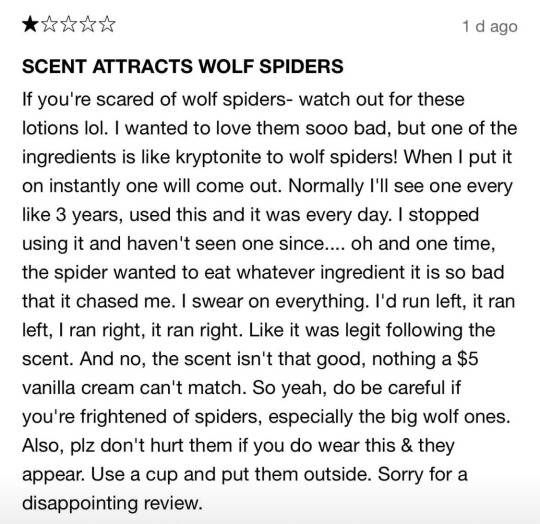


has anyone else been seeing the tweets about a lotion from sephora that attracts spiders
#monsterfucking cw#spider cw#drider#drabble#mallory dunlin writes#maybe the kinkiest thing I've ever written?#now you all get to know about my love for driders
85K notes
·
View notes
Text
Notes for drawing (and writing) insects
I do something like this almost yearly and it feels like it gets a little longer every time!
Personally I draw either cartoony stuff or hybrid monsters where none of this is mandatory, but here are some of the things I sometimes see missing or inaccurate in insect artwork that was meant to be lifelike, and even if you only do alien, monster or cartoon arthropods, or you don’t make art at all, you might still like to know some of these things!
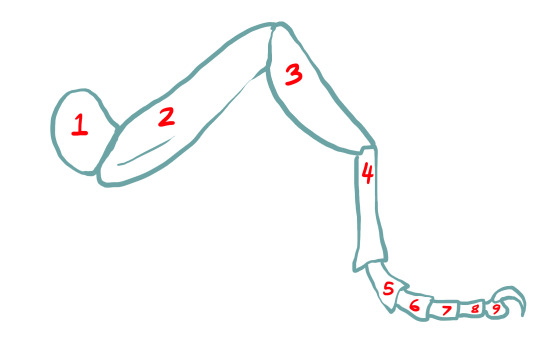
First off, an insect leg pretty much always has 9 segments. #1, the coxa, is what attaches it to the body and can be a short little “ball” or a whole long piece, but almost always bends DOWN. The last five segments are almost always very short, forming a super flexible “foot” or “tarsus” ending in a set of claws and sticky pads. All spiders have this “foot” as well!
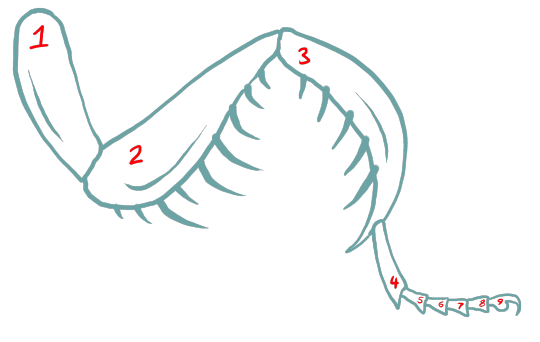
The foot is even still present on the claws of a preying mantis - growing right out of the “sickle” like this, and still used as feet when the mantis walks around or climbs. Basically ONLY CRABS have limbs ending in simple points!
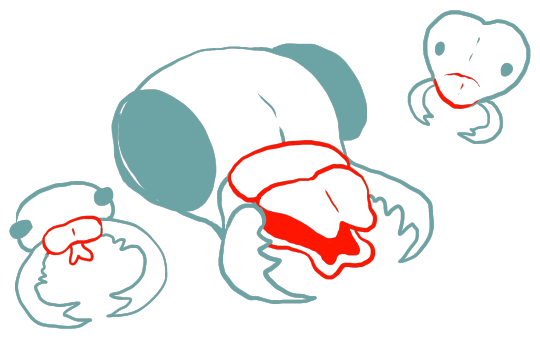
Insects don’t just have side-to-side mandibles at all, but an upper and lower set of “lips” like a duck bill! In some, however, these parts can be very small or even fused solid.
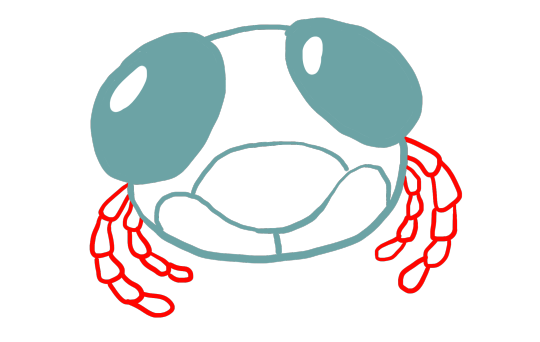
Insects also typically have four “palps” on their head, an upper and lower pair, which evolved from legs and are used to handle food!

Most *FLYING* insects have ocelli, single-lens eyes in addition to their multi-faceted compound eyes! Some flightless insects can also have them but it depends on the species.
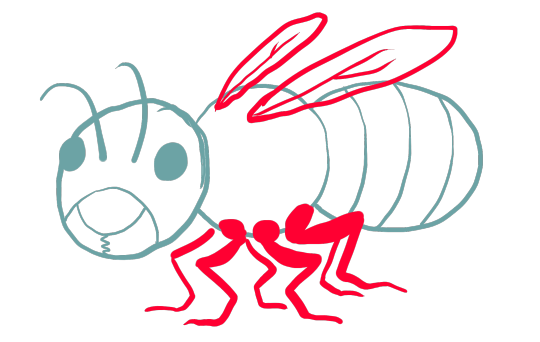
All legs and wings are always attached to the thorax!
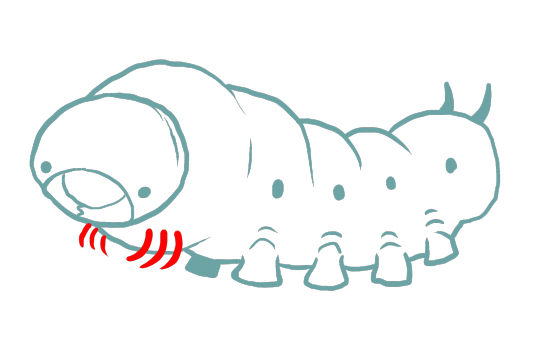
Caterpillars still have six legs! They’re very small and up near the head. All the other “legs” are actually just suckers on its underbelly.
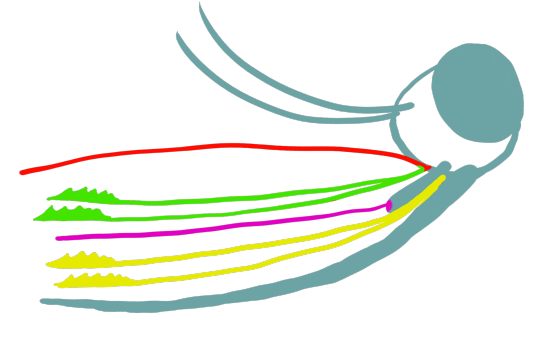
You will be forgiven for never drawing this but this is how many parts a mosquito’s mouth actually has. Every piece you can find in another insect’s mouth - the “upper lip,” the mandibles, the palps, etc. - are all present as different needles and blades!
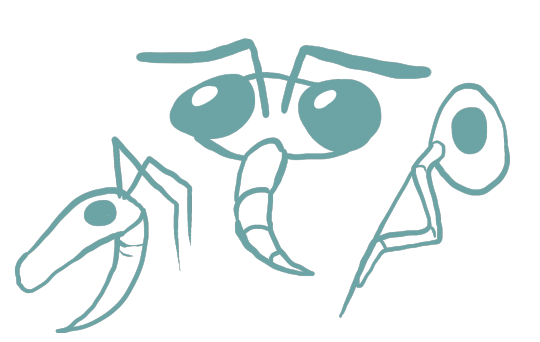
The word “bug” originally referred only to one group of insects, the hemiptera, including stink bugs, assassin bugs, aphids, cicadas, bed bugs and water striders to name a few. One distinguishing feature of this group is that it did away with all those separate mouth parts - all “bugs” have just a single, hollow “beak” or “proboscis” to feed through!
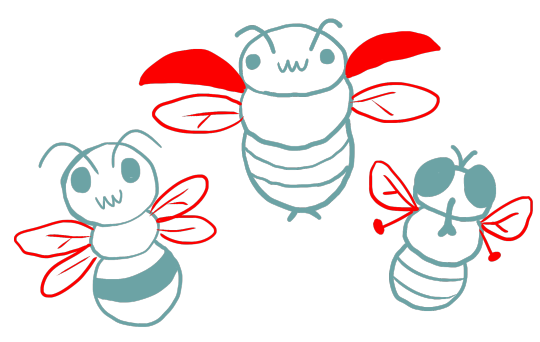
The vast majority of insect groups have wings or at least members with wings, and all insects with wings have FOUR of them.....except that in beetles, the front wings evolved into solid, protective shields for the hind wings, and in true flies (which includes mosquitoes!) the hind wings evolved into tiny little knobs with weights on the end, called halteres, which the fly’s fast-paced brain uses to feel its orientation, altitude, speed, surrounding air pressure and other fine data making them quite possibly the most advanced aerial navigators on the planet. OTHER NOTES THAT DON’T NEED ILLUSTRATION:
Insects and other arthropods HAVE TRUE BRAINS in their heads, made of brain cells like ours. They can learn, memorize, and make decisions.
Insects do have males and females and obviously only females lay eggs. Fiction is always getting this wrong, but I guess it also does so with birds so whatever.
Of insects, only termites, ants, some bees and some wasps have fully evolved a eusocial colony structure with “queens” as we think of them. Of these, the termites are actually highly specialized cockroaches, and the rest (bees, ants, wasps) are the same exact group.
The scrabbling, clicking noise associated with insects is usually added artificially in nature footage for dramatic effect. While their movements likely emit some sort of sound, it’s probably no “louder” proportionately than, say, the sound of a cat’s fur as it walks. In other words it should not be noticeable; what kind of animal survives as a species if it clatters with every step??
Compound eyes do not see a bunch of identical little images. There is no advantage to any organism seeing that way. An insect sees one big picture just like you do.
Only some insect groups have “larvae.” Others have “nymphs” which resemble fully grown but wingless insects.
The only insects with a venomous bite are some true bugs and some flies. There are no beetles or roaches or wasps or anything else that inject offensive toxins through their mouth parts, as far as I know!
The only insects that lay eggs inside other insects parasitically are certain wasps and flies. There are also NO arachnids that do this.
Only certain bees, wasps and ants have stingers on their abdomens. These are modified from egg laying appendages, so it’s also only ever the females.
The only other kind of “sting” in any insect is a venomous hair or spine, mostly seen in caterpillars.
17K notes
·
View notes
Text
Spitting Spider, Giant

“Spitting Spider a.k.a. Coconut” © deviantArt user “ssabbath”, accessed at their gallery here
[The ability of Pathfinder spiders to spray webbing, instead of necessarily waiting for creatures to stumble into it, reduces the special nature of real Scytodidae spitting spiders. The ability to store poison in the webbing, and to spray it accurately at great distances, help to make them still stand out a bit.]
Spitting Spider, Giant CR 4 N Vermin This man-sized spider has long thin legs and a humped, oversized head. It has six eyes, clustered in pairs. Droplets of amber liquid hang from its palps.
Giant spitting spiders are territorial predators. They roam the caverns and tunnels they call home in search of prey—the vibrations of any creature of Tiny or larger size felt on the ground are likely to attract their attention. A giant spitting spider has a venomous bite like other spiders, but can saturate its webbing with its venom and spray both at great distances. If they face multiple foes at once, they typically hold their ground, attempting to entangle and poison all of their foes before closing to finish the job with their chelicerae.
Giant Spitting Spiders as Vermin Companions Starting Statistics: Size Small; Speed 30 ft. climb 30 ft.; AC +0 natural armor; Attack bite (1d4 plus poison) or web (30 ft. range increment, ranged touch, entrap); Ability Scores Str 13, Dex 19, Con 12, Int —, Wis 11, Cha 6; Special Attacks poison (1d2 Str, Con-based DC), entrap (hardness 5, 1 hp/HD, Con-based DC)
4th-Level Advancement: Size Medium; AC +2 natural armor; Attack bite (1d4 plus poison) or web (50 ft. range increment, ranged touch, entrap plus poison); Ability Scores Str +4, Dex –2, Con +2; Special Attacks poison (1d3 Str, Con-based DC), entrap (hardness 5, 1 hp/HD, exposed to poison, Con-based DC)
Giant Spitting Spider CR 4 XP 1,200 N Medium vermin Init+3; Senses darkvision 60 ft., Perception +8, tremorsense 30 ft. Defense AC 15, touch 13, flat-footed 12 (+3 Dex, +2 natural) hp 45 (7d8+14) Fort +7,Ref +5,Will +2 Defensive Abilities mindless Offense Speed 30 ft., climb 30 ft. Melee bite +8 (1d6+4 plus poison) Ranged venom web +8 touch (entrap plus poison) Special Attacks entrap (DC 15, 1d10 minutes, hardness 5, hp 7) Statistics Str 17, Dex 17, Con 14, Int -, Wis 11, Cha 6 Base Atk +5;CMB +7;CMD 20 (32 vs. trip) Skills Climb +10, Perception +8, Stealth +7;Racial Modifiers +8 Perception, +4 Stealth Ecology Environment underground Organization solitary or pair Treasure none Special Abilities Poison (Ex) Bite or venom web—contact; save Fort DC 15; duration 1/round for 4 rounds; effect 1d3 Str damage; cure 2 saves. The save DC is Constitution based. Venom Web (Ex) As a standard action, a giant spitting spider can shoot a glob of venom-soaked silk. Treat this as a ranged touch attack with a range increment of 50 feet and five maximum range increments. A creature struck by this takes no damage, but must save against the spitting spider’s entrap and poison attacks
29 notes
·
View notes
Text
New spiders incoming!
Hey guys! Typing up a quick “””reveal””” about the tarantulas I should be adding to my collection as of next week! These will raise my numbers to somewhere around 130. I can’t promise photos immediately, but they’ll come! I intentionally buy most of my spiders as babies so I can raise them up myself, so they’re all going to be pretty tiny. Some rare ones though! I had a hay-day, and it’ll be a good boost for my Old World and Psalmopoeus sections. Bolded names are the rarer ones/the ones I’m most excited about.
Augacephalus ezendami (Mozambique Baboon)
Ceratogyrus meridionalis (Zimbabwe Grey Baboon)
Chilobrachys sp. “Kaeng krachan” (Dark Earth Tiger)
Cyriopagopus lividus (Cobalt Blue; a replacement for a sling that passed away)
Ephebopus rufescens (Burgundy Skeleton)
Holothele sanguiniceps (Trinidad Pink)
Homoeomma sp. Blue (Peruvian Blue Zebra)
Hysterocrates laticeps (Nigerian Brown)
Idiothele mira (Blue Foot Baboon; trying again for a female, since mine is now a mature male)
Kochiana brunnipes (Brazilian Dwarf Beauty)
Megaphobema mesomelas (Costa Rican Red Leg)
Psalmopoeus ecclesiasticus (Ecuadorian Olive-Grey Tree Spider)
Psalmopoeus victori (uncertain re: common name) !!!!!!!!!!!!
Pseudhapalopus sp. kurzhaar (MAYBE; unknown common name)
Theraphosinae sp. “Cuzco” (unknown common name)
Theraphosinae sp. “Panama” (unknown common name)
(Because I love to support the good breeders and sellers, check out Palp Friction Tarantulas. They’re an amazing team and have great reputations and, yes, this is a positive review before I even receive the new tarantulas because I know that even if there is an issue they’d fix it one-hundred percent. Consider buying from Palp Friction if you’re looking for well-kept tarantulas and a huge variety of species. The majority of the species listed here I am receiving from them.)
4 notes
·
View notes
Photo




wormsandbones.com
Anyone who knows me knows I love spiders. I have Halloween decorations that probably qualify as antique now they're so old, just because they have spiders of 'em. I have Christmas decorations that are spider themed. My work space includes three actual tarantula tanks. And Bones is arachnophobic. So imagine my surprise when she was on board to make spiders. At any rate, these guys are roughly a foot across, and fully articulated from toes to palps. They can curl up and play dead, hang off your light fixture (but really, why would you want that), hold small objects and stare accusingly at you while you procrastinate (they're good at this. Ask me how I know.). They're both handmade, with cast resin 'heads' and soft faux fur & minky bodies. Since these guys are the last of the first gen spiders we'll be making, we've discounted them a little bit. Future spiders will be a lil' different, so if you like this version, now is your chance.
142 notes
·
View notes
Photo
I wouldn't be so hasty with that declaration; this is what tarantula feet look like. Looking at all of the drider art and considering the environment of the underdark I don't think we're looking at tarantula based critters. (Heck tarantulas are not even part of the 'true spider' classification.)
Lets look at some other spider feet...

Widows don't have the same lil paws, even if they aren't just a simple point.

A- Vinathela tonkinensis (Vinathela is a genus of simple trapdoor spiders from SE Asia) B- Harpactea hombergi (Harpactea is a genus of woodlouse hunting spiders ranging from Europe to North Africa) C- Philodromus bistigma (Philodromus is a genus of widespread crab spiders) D- Palpimanus gibbulus (Palpimanus is a genus of spiders from tropical and subtropical areas with highly developed and strong front legs. They are known as 'palp footed spiders') E- Scytodes thoracica (Scytodes is a genus of spiders known as 'spitting spiders'. They have a wide distribution and hunt by spitting envenomed gunk at their prey)
Spiders come in an enormous range of varieties and lifestyles, meaning they have many different sorts of feet. If one wanted to get technical with driders and their arachnid anatomy it could be worthwhile to sit down and have a think about what kind of features they might have to suit their lifestyle and start looking at spider genera.
I'm glad everyone is so excited for cute little spider paws but they are a gross simplification of what spider anatomy is like, to the point of misinformation. And that makes this science educating DnD nerd sad.


Tarantula feet, Selenocosmia sp. and Phormingochilus sp.
Photos by Nicky Bay // Website // Facebook
Shared with permission; do not remove credit or re-post!
#Lorien rambles#cw spider#also declaring 'this is how it is' for a whole fandom makes me go :/#even when well intended#but if you want to draw driders as having tarantula anatomy go for it that'd be awesome#nature is fascinating
6K notes
·
View notes
Text
did you know spider families have the best common names? a list of araneomorphae names from some wiki page i’m looking at:
araneomorph funnel-web spiders tangled nest spiders anyphaenid sac spiders orb-weaver spiders pelican spiders sac spiders dark sac spiders tropical wolf spiders net-casting spiders intertidal spiders coneweb spiders false violin spiders woodlouse hunter spiders velvet spiders crevice weavers flat-bellied ground spiders large-clawed spiders dwarf sheet spiders tree trunk spiders lampshade spiders White-tailed spider Tooth cave spider dwarf / money spiders liocranid sac spiders wolf spiders shield spiders pirate spiders long-legged sac spiders spurred orb-weavers cave cobweb spiders midget ground weavers disc web spiders dwarf hunting spiders lynx spiders palp-footed spiders philodromid crab spiders daddy long-legs spiders nursery web spiders long-spinneret ground spiders jumping spiders spitting spiders tubeweb spiders wall spiders recluse spiders huntsman spiders dwarf orb-weavers long-legged cave spiders armored spiders long jawed orb-weavers cobweb spiders ray spiders crab spiders hackled orb-weavers ant spiders
are the names that good or does everything sound great with the word SPIDERS after it? YOU BE THE JUDGE
1 note
·
View note
Text
The most astonishing wildlife photos of 2019 range from meme-able to political
<strong>The moment</strong> (Yongqing Bao / Wildlife Photographer of the Year/)
An opalescent squid drifts in the inky darkness of the ocean at nighttime. A marmoset with a face full of terror leaps away from a lunging fox. Hot tongues of lava emit clouds of noxious steam. These are some of the moments captured by the winners of the 2019 London Natural History Museum's annual Wildlife Photographer of the Year competition.
Wildlife photography requires a truly astounding amount of patience, planning, and luck. This year’s winners tracked colonies of army ants through the rainforest, camped out in snow-covered deserts, and hid behind underwater shipwrecks in an effort to showcase the diverse majesty of wild places and beings. And they weren’t alone: The contest received more than 48,000 entries from 100 different countries in its 55th running.
Photographer Yongqing Bao received the prestigious Wildlife Photographer of the Year award for "The moment," a gripping action shot featuring a standoff between a marmoset and its foxy predator. According to the judges, the image deftly combines "horror and humor" to capture "the drama and intensity of nature." The image was taken on the rarely photographed Qinghai-Tibet Plateau.
Some winners chose to use their artistry as an opportunity for political and social commentary, like “Single Image” finalist Alejandro Prieto. The Mexican photojournalist projected an enormous image of a jaguar onto the border wall and snapped the image he would call “Another barred migrant.”
Ultimately, 19 winners were chosen for 18 different categories (with a joint award shared by two photographs for "Animal Behavior.") These photographs, along with dozens of other notable submissions, will go on display at the London Natural History Museum starting Friday, October 18.
<strong>Another barred migrant</strong> (Alejandro Prieto / Wildlife Photographer of the Year/)
Winner 2019, Wildlife Photojournalism: Single Image
Nikon D850 + Sigma 14–24mm f2.8mm lens at 16mm; 30 sec at f2.8; ISO 1600; remote control; Gitzo tripod; Epson projector
Under a luminous star-studded Arizona sky, an enormous image of a male jaguar is projected onto a section of the US-Mexico border fence—symbolic, says Alejandro Prieto, of “the jaguars’ past and future existence in the United States.” Today, the jaguar’s stronghold is in the Amazon, but historically, the range of this large, powerful cat included the southwestern US. Over the past century, human impact—from hunting, which was banned in 1997 when jaguars became a protected species, and habitat destruction—has resulted in the species becoming virtually extinct in the US. The photograph projected on the border wall is of a Mexican jaguar, captured with camera traps that Prieto has been setting on both sides of the border and monitoring for more than two years. The shot of the border fence was created to highlight President Trump’s plan to seal off the entire US‑Mexico frontier with an impenetrable wall and the impact it will have on the movement of wildlife, sealing the sad fate of jaguars in the US.
<strong>Night glow</strong> (Cruz Erdmann / Wildlife Photographer of the Year/)
Winner 2019, 11-14 years old
Canon EOS 5D Mark III + 100mm f2.8 lens; 1/125 sec at f29; ISO 200; Ikelite DS161 strobe
Cruz Erdmann was on an organized night dive in the Lembeh Strait off North Sulawesi, Indonesia and, as an eager photographer and speedy swimmer, had been asked to hold back from the main group to allow slower swimmers a chance of photography. This was how he found himself over an unpromising sand flat, in just 10 feet of water. It was here that he encountered the pair of bigfin reef squid. They were engaged in courtship, involving a glowing, fast‑changing communication of lines, spots and stripes of varying shades and colors. One immediately jetted away, but the other—probably the male—hovered just long enough for Erdmann to capture an instant of its glowing underwater show.
<strong>The architectural army</strong> (Daniel Kronauer / Wildlife Photographer of the Year/)
Winner 2019, Behavior: Invertebrates
Canon EOS 7D + 16–35mm f2.8 lens at 16mm + extension ring; 3.2 sec at f22; ISO 100; Canon Speedlite flash
At dusk, Daniel Kronauer tracked a colony of nomadic army ants as it moved, traveling up to a quarter of a mile through the rainforest near La Selva Biological Station, northeastern Costa Rica. While it was still dark, the ants would use their bodies to build a new daytime nest to house the queen and larvae. They would form a scaffold of vertical chains by interlocking claws on their feet and then create a network of chambers and tunnels into which the larvae and queen would be moved from the last nest. One night, the colony assembled in the open, against a fallen branch and atop two large leaves, creating a structure that spanned 20 inches and resembled “a living cathedral with three naves.”
<strong>The garden of eels</strong> (David Doubilet / Wildlife Photographer of the Year/)
Winner 2019, Underwater
Nikon D3 + 17–35mm f2.8 lens at 19mm; 1/40 sec at f14; ISO 400; Seacam housing; aluminium plate + ballhead; remote trigger; Sea & Sea YS250 strobes (at half power)
This colony of garden eels was one of the largest David Doubilet had ever seen—at least two thirds the size of a football field, stretching down a steep sandy slope off Dauin, in the Philippines. These warm-water garden eels are extremely shy, vanishing into their sandy burrows the moment they sense anything unfamiliar. Doubilet placed his camera housing just within the colony and hid behind the remnants of a shipwreck. From there he could trigger the system remotely via a 40-foot extension cord. It was several hours before the eels dared to rise again to feed on the plankton that drifted by in the current. He gradually perfected his set-up, each time leaving an object where the camera had been so as not to surprise the eels when it reappeared. Several days later—now familiar with the eels’ rhythms and the path of the light—he began to get images he liked. When a small wrasse led a slender cornetfish through the gently swaying forms, he had his shot.
<strong>The equal match</strong> (Ingo Arndt / Wildlife Photographer of the Year/)
Joint Winner 2019, Behavior: Mammals
Canon EOS-1D X Mark II + 600mm f4 lens; 1/3000 sec at f4; ISO 1000; Gitzo tripod
Fur flies as the puma launches her attack on the guanaco. For Ingo Arndt, the picture marked the culmination of seven months tracking wild pumas on foot, enduring extreme cold and biting winds in the Torres del Paine region of Patagonia, Chile. For half an hour, Arndt watched this female puma creep up on the large, male guanaco. When the puma was within about 30 feet, she sprinted and jumped. As her claws made contact, the guanaco twisted to the side, his last grassy mouthful flying in the wind. The puma then leapt on his back and tried to deliver a crushing bite to his neck. Running, he couldn’t throw her off, and it was only when he dropped his weight on her, seemingly deliberately, that she let go, just missing a kick that could easily have knocked out her teeth or broken bones. Four out of five puma hunts end like this—unsuccessfully.
<strong>Creation</strong> (Luis Vilariño Lopez / Wildlife Photographer of the Year/)
Winner 2019, Earth’s Environments
Sony α7R III + 100–400mm f4.5–5.6 lens at 196mm; 1/4000 sec at f5.6; ISO 800
Red-hot lava tongues flow into the Pacific Ocean, producing huge plumes of noxious laze—a mix of acid steam and fine glass particles—as they meet the crashing waves. Kîlauea started spewing out lava through 24 fissures on its lower East Rift at the start of May 2018. In a matter of days, the lava had reached the Pacific on the island’s southeast coast and began the creation of a huge delta of new land. It would continue flowing for three months. By the time Luis Vilariño Lopez could hire a helicopter to fly over the area, the new land extended more than a mile from shore. Framing his shot through the helicopter’s open door, Vilariño Lopez captured the collision boundary between molten rock and water and the emergence of new land.
<strong>Snow exposure</strong> (Max Waugh / Wildlife Photographer of the Year/)
Winner 2019, Black and White
Canon EOS-1D X + 100–400mm f5.6 lens at 200mm; 1/15 sec at f22 (+1 e/v); ISO 100
In a winter whiteout in Yellowstone National Park, a lone American bison stands weathering the silent snow storm. Shooting from his vehicle, Max Waugh could only just make out its figure on the hillside. Bison survive in Yellowstone’s harsh winter months by feeding on grasses and sedges beneath the snow. Swinging their huge heads from side to side, using powerful neck muscles—visible as their distinctive humps—they sweep aside the snow to get to the forage below. Slowing his shutter speed to blur the snow and “paint a curtain of lines across the bison’s silhouette,” Waugh created an abstract image that combines the stillness of the animal with the movement of the snowfall.
<strong>Face of deception</strong> (Ripan Biswas / Wildlife Photographer of the Year/)
Winner 2019, Animal Portraits
Nikon D500 + 18–55mm lens (reverse mounted); 1/160 sec; ISO 200; Godox V860II flash
This may look like an ant, but then count its legs —and note those palps either side of the folded fangs. Ripan Biswas was photographing a red weaver ant colony in the subtropical forest of India’s Buxa Tiger Reserve, in West Bengal, when he spotted the odd-looking ant. On a close look, he realized it was a tiny ant-mimicking crab spider, just 1/5 of an inch long. Many spider species imitate ants in appearance and behavior—even smell. Infiltrating an ant colony can help a spider wanting to eat ants or to avoid being eaten by them or by predators that dislike ants. This particular spider seemed to be hunting.
<strong>Snow-plateau nomads</strong> (by Shangzhen Fan / Wildlife Photographer of the Year/)
Winner 2019, Animals in Their Environment
Nikon D5 + 600mm f4 lens; 1/1250 sec at f6.3 (+0.3 e/v); ISO 125; Gitzo GT5532S 6X tripod
A small herd of male chiru leaves a trail of footprints on a snow-veiled slope in the Kumukuli Desert of China’s Altun Shan National Nature Reserve. These nimble antelopes—the males with long, slender, black horns—are high-altitude specialists, found only on the Qinghai–Tibet Plateau. A million chiru once ranged across this vast plateau, but commercial hunting in the 1980s and 1990s left only about 70,000 individuals. In winter, many chiru migrate to the relative warmth of the remote Kumukuli Desert. For years, Shangzhen Fan has made the arduous, high-altitude journey to record them. On this day, the air was fresh and clear after heavy snow. Shadows flowed from the undulating slopes around a warm island of sand. From his vantage point more than half a mile, Fan drew the contrasting elements together before they vanished.
<strong>The moment</strong> (Yongqing Bao / Wildlife Photographer of the Year/)
Joint Winner 2019, Behavior: Mammals
Canon EOS-1D X + 800mm f5.6 lens; 1/2500 sec at f5.6 (+0.67 e/v); ISO 640; Manfrotto carbon-fibre tripod + 509HD head
It was early spring on the alpine meadowland of the Qinghai–Tibet Plateau, in China’s Qilian Mountains National Nature Reserve, and very cold. The marmot was hungry. It was still in its winter coat and not long out of its six-month, winter hibernation, spent deep underground with the rest of its colony of 30 or so. It had spotted the fox an hour earlier, and sounded the alarm to warn its companions to get back underground. But the fox itself hadn’t reacted, and was still in the same position. So the marmot had ventured out of its burrow again to search for plants to graze on. The fox continued to lie still. Then suddenly she rushed forward. And with lightning reactions, Yongqing Bao seized his shot. His fast exposure froze the attack.
Wildlife Photographer of the Year is developed and produced by the Natural History Museum, London.
from Popular Photography | RSS https://ift.tt/2Bm2EZW
0 notes
Text
November 25, 2017 at 12:39AM
Today I learned: 1) Two new butterfly anatomy facts! Firstly, butterfly proboscuses don't work the way I thought. I always assumed they were like needles, and that butterflies stick them into nectar-rich flowers and suck up the nectar like a straw. I was sorely mistaken. In fact, butterfly proboscuses come in two parts, left and right, that zip together. The center of this double-proboscus structure forms a canal. The tip of the proboscus isn't just an open end -- it's actually more like a sponge, with lots of layers of tiny pores. Liquid is drawn into the pores by capillary action, eventually bleeding into the central canal. In the canal, liquid forms little tiny bridges between proboscus zipper teeth, kind of like water caught between teeth of a comb. Some fancy fluid dynamics that I don't understand draws the liquid up, aided by a bit of suction generated by an inflatable air sack in the butterfly's head. Okay, second new anatomy fact -- in addition to antannae, butterflies have a pair of antenna-like fuzzy bits that rest right up against the head, next to their eyes. A bit of googling tells me that they're called "labial palps", and that they're essentially used for smelling. Some up-close observation of a butterfly suggests to me that they're also used as windshield wipers to clean their eyes. 2) So, everyone knows that Dolly the sheep was the first cloned mammal. Some know that Dolly died early, with pretty bad arthritis and some other medical problems. That's one of the reasons scientists haven't pursued mammalian cloning very much -- it looks like cloning isn't very good for mammals, for reasons nobody could really understand. Well... now it looks like Dolly was just an outlier. There were four other sheep cloned from the same cell line as Dolly, and they all lived pretty normal, healthy lives. Moreover, it seems that arthritis is super-common in that breed of sheep, and that it isn't particularly unusual for a sheep her age to get arthritis. Now, cloning isn't *totally* healthy -- clones tend to have more difficult, dangerous births, and require more care as infants, but once they're grown they seem to do just fine. Also, I didn't realize that mammalian cloning *has* in fact been used commercially to reproduce extremely valuable breeding cows and steers. This isn't quite new news, but for some reason this has hit some popular news outlets lately. For a reputable source, I'd check out The Atlantic's article on the subject: http://ift.tt/2mXE11y 3) There are some really strange-looking lobsters out there. Today I learned about one of these -- the slipper lobster. The slipper lobster looks a bit like someone painted a small Maine lobster gray and squished it from nose to tail. It's very squat, almost pug-nosed. It has no claws, just arms ending in shell plates. It also has the unfortunate double distinction of being endangered and incredibly tasty. Facts #1 and #3 are courtesy of the Denver Butterfly Pavilion, which it turns out is a zoo of all kinds of different invertebrate species. Some highlights of mine include a glassed-in honeybee hive, some really spectacular orb weaving spiders, two foot-long isopods, and, of course, the butterfly garden.
0 notes